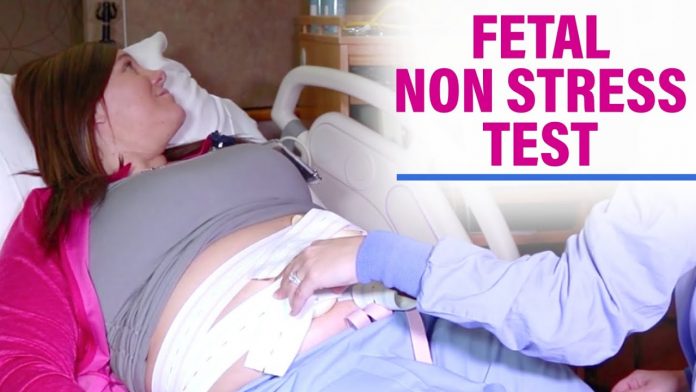Stress-free testing may be a standard prenatal check for a baby health nonstress tests. Throughout the stress-free examination process, the baby’s pulse is monitored to ensure that it responds to the baby’s movement. The term “stress-free” refers to the fact that during the entire examination, nothing can put pressure on the baby.
Usually, once it is believed that the baby is at an increased risk of death, a stress-free examination is generally recommended. Stress-free studies can also be performed from 26 to 28 weeks after delivery. The results of a stress-free test may indicate that you and your baby need observation, testing, or special care.
The non-stress test can be a non-invasive test and does not pose any physical risk to you or your baby.
Why do
Use a stress-free test to determine the baby’s health before birth. The purpose of stress-free testing is to provide useful information about the baby’s gas supply by checking the baby’s pulse and how it responds to the baby’s movement. The inspection may indicate that any observation, testing, or delivery is required.
Usually, babies beat their hearts when they are more active postpartum. However, conditions such as vertebrate expulsion (once the baby does not have enough gas) will disrupt this response.
Your health care provider may recommend a stress-free examination if you have the following conditions:
Multiple pregnancy comorbidities
Potential medical diseases, such as a type of polygenic disorder, cardiovascular disease, or high vital signs of the entire mother
- Fertility period has exceeded your maturity period (full-term pregnancy)
- Had a history of extreme maternal complications
- A baby’s World Health Organization downplays vertebrate activity or attainable vertebrate.
growth issues
Rh (rhesus) sensitization-Once your red blood cell blood type is blood type, and the baby’s blood type is Rh-positive, serious illness may occur in the second or subsequent maternal
Low humor (too little amniotic fluid)
Your health care provider may advocate stress-free testing once or twice a week (sometimes daily) to check your health and your baby’s health.
Risky
The non-stress test can be a non-invasive test that does not pose a physical risk to you or your baby. The term “stress-free” refers to the fact that during the entire examination, nothing can put pressure on the baby.
Stress-free testing can provide support for your baby’s health, but it can also cause anxiety. Performing a stress-free inspection may recommend inspection in the absence of flame retardants, which may result in any testing. In the long run, encouraging results are not predictions.
Also, keep in mind that although it is generally recommended to increase the risk of maternal fertility after a maternal examination, the usefulness of such an analysis is inconclusive.
How do you prepare
Stress-free inspections usually do not require special preparation.
What you can expect
Stress-free testing can sometimes exhaust your healthcare provider’s workplace.
Before the program
You will get vital signs before starting a stress-free exam.
Why conduct stress-free testing of regional units?
Sometimes, once a healthcare provider wants to know the health of the skull, a stress-free examination (NST) can be performed, for example, in an extremely unsafe mother or once mature.
This check checks to determine whether the baby usually responds to the stimulus and gets enough gas. Babies who do not respond are not dangerous and may need other tests.
Sometimes, biophysical characteristics (BPP) are completed, which includes AN and NST. In addition to the central rate response, BPP also checks the baby’s breathing, movement, humor volume, and intonation.
In the program
During a stress-free examination, you may lie on a recliner. Throughout the examination process, you will regularly obtain vital signs.
Your healthcare provider or a member of the healthcare team can place a device around the abdomen that can measure the pulse of vertebrates.
Usually, the stress-free check will last for 20 minutes. However, if your baby is not active or asleep, you should probably extend the exam by 20 minutes (in the hope that your baby can become active) to ensure the results are correct. Your health care provider may stimulate the baby by inserting a noise-generating device in the abdomen.
After the program
After completing the stress-free exam, your healthcare provider seems to be able to discuss the results with you immediately.
What happens during the entire non-stress test?
The examination may also exhaust the unique prenatal examination space of the hospital. Otherwise, your care provider’s workplace will be spent.
The process may be different, but a routine non-stress check might look like this:
You will maintain a comfortable position on the AN inspection table. The supplier puts the gel on your stomach. He or she wears a seat belt on your abdomen. A tool called electrical equipment is connected to the belt. This is an external vertebrate pulse monitor. The supplier puts it on the baby’s heartbeat.
- The baby’s pulse is recorded on the monitor and paper output signal.
- Every time you feel the baby moving, the system will ask you to press the button on the monitor.
- The test sometimes lasts 20 to 40 minutes.
In some cases, once there is a little exercise, the test will be performed throughout the baby’s sleep cycle. You can also get used to waking up babies with exceptional sound (acoustic) equipment. It placed on the mother’s belly and made a buzzing sound. This will not be harmful to the baby. However, this will make the sleeping baby more active. If you eat or drink water, your baby may also wake up.
What happens once a non-stress test is performed?
The supplier can remove the belt and electrical equipment and wipe off the gel. You will be informed of the inspection results.
The test results of the non-stress check may be:
- Reactivity (typical). The baby’s pulse rises two or more times within the test volume.
- no response. Once the baby moves, the baby’s pulse will not change. This may mean that you need different tests.
An unresponsive and stress-free test does not mean that your baby is permanently defective. The baby may just be sleeping. Otherwise, as the baby is immature, it will become unresponsive. Premature babies will usually undergo a non-responsive, stress-free test, especially before 28 weeks. Your care provider can tell you if you want to perform other prenatal tests.
Next step
- Before performing checks or steps, please confirm:
- Check or procedure name
- The reason for your check or procedure
- Expected results and their meaning
- Risks and advantages of inspections or procedures
- What are the achievable aspects or regional units of complications
When and where do you have a check or program
- Who can conduct inspections or procedures and the qualification of the person in the regional unit
- What if you may not have a check or procedure
- Any acceptable test or procedure
- When and where do you get results
- If you have questions or problems, who will decide the inspection or procedure
- How many checks or procedures should you master
result
Considered the results of the non-pressure inspection area unit:
Active response. Before the 32nd week of maternity leave, if your baby’s heartbeat accelerates at least ten seconds every 20 minutes, treat the resulting area unit as traditional (reactive), at least twice or more than the baseline . During the thirty-second week of maternity leave or later, if your baby’s heartbeat accelerates to at least every 15 seconds at least every 15 seconds at an absolute level above the baseline that is twice or more than the baseline, the result Regional units will be considered reactive.
no response. If the baby’s heartbeat does not meet the above-represented standard,
the resulting regional unit is considered unresponsive. Throughout the examination, if your baby is inactive or asleep, it may cause unresponsive results.
Biophysical characteristics. Biophysical features combine stress-free examination with vertebrate ultrasound to assess infants’ breathing, body movement, tension and humor levels.
Determination of shrinkage. Once the uterus has contracted, this test will appear at the baby’s pulse and respond.
Your health care provider may raise you on the same day so you have another stress-free exam.
In addition to skull inactivity or falling asleep, other achievable causes of unresponsive, stress-free test results include flirty gas (hypoxia of the fetus), maternal smoking, maternal drug use, vertebrate drugs, or visceral abnormalities.
Make sure to discuss the results of stress-free tests with your health care provider and what they mean for you and your baby.
Relevant risks
People who don’t talk about stress don’t think people who take risks look at it. It is non-invasive and does not require blood samples or invasive tests. Perhaps the most important risk is wrong information 2.
If you have considerations, please talk to your professional before taking a look. They will assure you, but they are working hard to mitigate the harm to you and your children.
Alternatives
There are regional units 2 that can replace non-stress tests: stress tests or biophysical features. 3 and keep in mind that alternatives are not always fascinating, and you can also choose to delay non-stress tests or not choose a stress-free look.
What happens to the NST associate degree
If the baby is still not as responsive as they are, for example, you may want to undergo a biophysical examination or test, or if you are approaching or exceeding the date of the appointment, you may be lured.
Words from Wellville
The method and reason for completing this operation may also vary by profession. If you have questions, please take a look. The purpose of the look is to finally convince you and your practitioners that everything is going well. If you do not feel this support, please speak carefully and ask questions.
Is a nonstress test really necessary?
Certain non-stress test results may indicate that you and your baby need further monitoring, testing, or special care.
What are three indications for conducting a non stress test?
Indications for prenatal stress-free testing include [3]: Fetal growth restriction. Diabetes treated with drugs, pre-pregnancy and gestational diabetes. Hypertensive diseases, chronic hypertension and pre-eclampsia. \
How often should NST be done?
How often to check during pregnancy. If you have a high-risk pregnancy, women may start a stress-free test every week or twice a week after 28 weeks. (Before 28 weeks, the test is not accurate.) If the baby is in poor health, it may only be necessary to perform an isolated NST.







